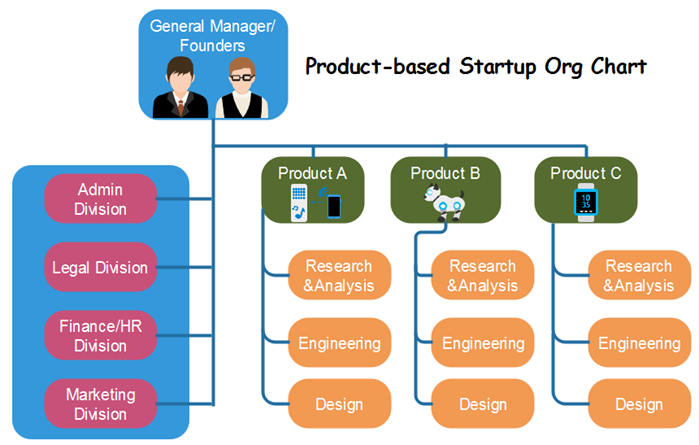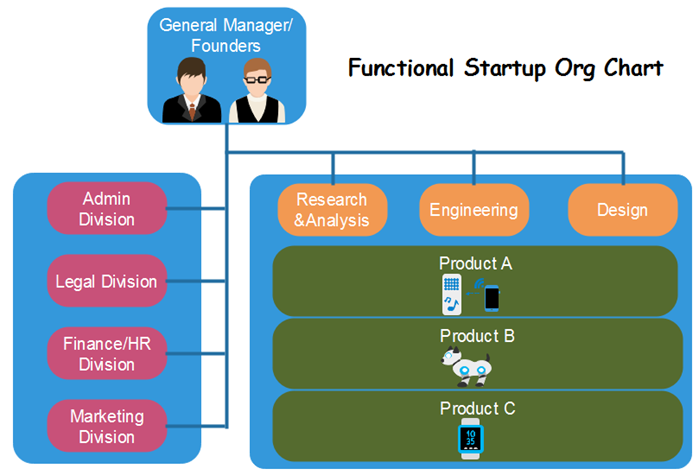You are telling people about your business since the minute you start creating the startup org chart. Traditionally, people use org charts to explain who works with whom in an organization. Furthermore, an effective startup org chart can really have a considerable impact on your business. So… just thinking about how to boom your productivity via org charts.
Startup Org Chart: What Is Your Business Type?
Product or Service-based Framework
This type usually has a number of products waiting for development. The shared divisions are all the same for each of the product team. The sub-departments of each product team are normally also the same. The type is used when each product features have a considerable difference in the development process.

This type indicates that all the functional divisions are shared with each of the product team. The type is used when each product features have many common points in the development process.

- Org Chart Made by the org chart creator.
- More Easy Org Chart Creator for Professionally Managing Your Business Teams
A No-org Chart Culture?
If you wanna give a shoot to the no-org chart culture, you should talk openly with your teammates about your purposes, ideas, and roles for everyone. Such type does not work for every team unless you are really eager to find new inspiration.
What Specific Steps and Reminders Do You Need to Consider?
If the number of total employee in your team is somewhere around 20, then you should follow these tactical steps to implement a strong organizational structure:
1) Decide Your Company Elements.
The majority of companies need to excel in several areas to be successful. However, you cannot be good at everything, so your business should focus on some competencies rather than others. Thinking about what is really important for your team? Asking yourself a series of questions including: Do I really need a product design? How many customer service assistants are necessary? If you are looking for marketing talents, you may consider the localization of your product.
2) Create meaningful groups.
The certain roles of your team should be empowered within the whole team to align with the type of company you plan to be. For example, if you put marketing as one of the dominant elements of your business, then marketers should be placed in key decision-making positions.
3) Keep an Eye on the Key Players in Your Team.
You should be embraced by the most significant employee at your company. Such people may be included in your board members, your outside business partners, or some other senior directors. Bring in the professionals at the right time to improve your business.
4) Open to Flexibility.
The main purpose of creating your startup org chart is not stepping on each other’s toes, so you should open to change. Normally the management level of a startup should revisit their roles regularly to ensure that there are no “holes” to make your business successful in the overall structure of your org chart.

5) Leave room for new employees.
As the development of your business, you may need to hire more talents to join your plan. Therefore thinking about which specific positions will these new employees fit in? As you generate more sub-divisions in your startup org chart, roles will inevitably become more specialized.
6) Have Your Startup Org Chart be Reviewed.
You should give your team members a chance to review themselves. Employees should get used to giving feedback. Make sure that your peer review is doing constantly based on monthly or weekly. Therefore, you would find a better way to communicate with your members.
7) Communicate with Your Board of Directors.
Talking with the board is key. The communication process doesn’t have to be formal but should be frequent. Your board members may have rich experience in setting up startups, so they can assist you to navigate the waters. At the final stage, you must be comfortable and in line with all the decisions being made.
8) Keep Your Startup Org Chart Up-to-date with Your Employee.
This is probably the most delicate step. For the majority of employees, the change of org charts is very sensitive. Such changes may influence daily business activities and the perceptions of existing employees.

Final Thought
Generally, small teams have more autonomy but meanwhile remain the passion. While it is an exciting sign that your team develops from a few founders to a real office, it is also the time that growing pains can begin to release. You, as the very first owner, should definitely be thinking about how to define more roles for your team and monitor your employees.
